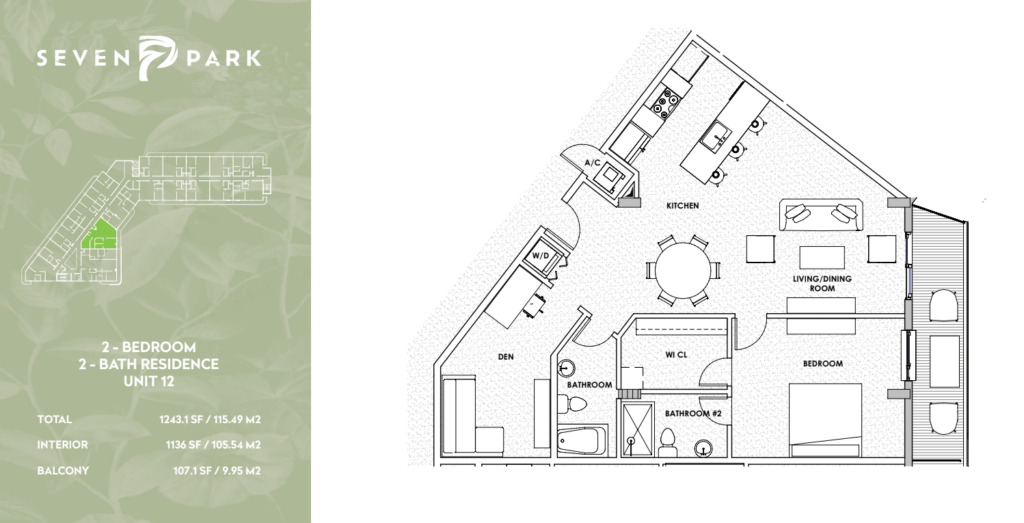Introduction: Why Floorplans Matter More Than You Think
Whether you’re investing in a pre-construction unit, buying a luxury condo in a new development, or relocating to a fast-growing urban hub like Toronto or Miami, understanding how to read a condo floorplan like a pro is a vital skill.
Too often, buyers focus only on square footage or bedroom count—but miss crucial layout flaws that impact everyday living, long-term value, and rental appeal.
Floorplans are the blueprint of your investment. Reading them properly can help you spot wasted space, assess natural light, visualize furniture flow, and even predict future resale performance.
In this guide, we’ll break down how to interpret condo floorplans accurately—so you can make confident, data-driven decisions on your next purchase.
The Basics of Condo Floorplans
What Is a Condo Floorplan?
A condo floorplan is a scaled 2D drawing that shows the layout of a unit from a bird’s-eye view. It includes:
- Walls and doorways
- Kitchen and bathroom placements
- Windows and balconies
- Room dimensions
- Appliance and fixture locations
Think of it as the architectural roadmap for how the space functions.
Why Floorplans Can Be Misleading
Don’t be fooled by beautifully staged showrooms or glossy renderings—floorplans offer the most honest look at what you’re actually buying.
However, they can also be confusing or incomplete. Key things to watch for:
- Measurements may not include walls (check if dimensions are interior or exterior)
- Room labels can be misleading (e.g., “den” might be a glorified hallway)
- Visual proportions aren’t always accurate (a walk-in closet might appear larger than it is)
Reading between the lines helps you avoid surprises when you finally walk into your finished unit.

Click here to see Seven Park on Condosglobal.com (One of the newest offerings) 🔗
How to Read a Condo Floorplan Like a Pro
Let’s walk through the key elements you should analyze in every floorplan—using real-world examples where appropriate.
1. Understand the Scale and Orientation
Look for the scale indicator—usually listed as 1/8” = 1’, or metric equivalents. This helps you mentally convert dimensions.
Then, find the compass rose or North arrow. This tells you which way the unit faces—critical for:
- Sun exposure (south-facing units get more natural light in North America)
- Views (city skyline vs. concrete wall)
- Noise (street-facing vs. courtyard)
Example: A southeast-facing corner unit will enjoy morning light and partial water views if it’s near the lake.
2. Analyze the Entryway
Is the front door opening directly into the kitchen or living room? Is there a hallway or coat closet?
A good entry design offers:
- Privacy from the hallway
- Storage for shoes/jackets
- A logical flow into the unit
If your door opens straight into a kitchen island, that may be a red flag for privacy and space planning.
3. Focus on the Living and Dining Area
Ask yourself:
- Is the layout open-concept or segmented?
- Where would your couch and dining table go?
- Do windows line up with the living space (natural light!)?
Many buyers overlook “dead space”, such as awkward corners or oversized hallways that eat into usable square footage.
Pro tip: Units that are wide and shallow often feel larger than ones that are long and narrow—even at the same square footage.
4. Review Kitchen Layout and Flow
Look at:
- Appliance placement
- Countertop space
- Islands vs. peninsulas
- Pantry options
Is there room to open the fridge door fully? Can more than one person move around the kitchen comfortably?
A smart kitchen layout is crucial for both everyday living and rental desirability.
5. Evaluate Bedroom Size and Separation
Check:
- Are bedrooms on opposite sides of the unit (ideal for privacy)?
- Can the room fit a queen or king-sized bed with nightstands?
- Is there a window and closet in each bedroom?
Be cautious of floorplans that call something a “bedroom” but offer no window or only a sliding wall.
6. Pay Attention to Bathrooms
Key things to spot:
- Are the bathrooms ensuite, or do guests need to walk through the bedroom?
- Is there a bathtub, a shower, or both?
- Is the sink area cramped?
Also note whether bathrooms share a wall with bedrooms—noise matters.
7. Look at the Den, Flex, or Office Space
More and more floorplans include dens or “flex spaces” to appeal to remote workers.
Questions to ask:
- Is it big enough for a desk and chair?
- Does it have natural light or ventilation?
- Is it a true room, or just an open nook?
For investors, this space could appeal to tenants needing a home office—if it’s usable.
8. Check the Balcony or Outdoor Space
If outdoor space is included, analyze:
- Size and shape (can you fit a table and chairs?)
- Privacy (is it recessed or jutting out?)
- Access point (from living room or bedroom?)
Not all balconies are created equal—some are barely usable, others become a genuine selling point.
9. Identify Mechanical Areas and “Loss” Space
Watch out for:
- HVAC closets or utility shafts
- Bulkheads and structural columns
- Wasted space in long hallways
These reduce usable square footage and sometimes disrupt furniture placement.
Key Tips for Different Buyer Types
For Investors
Learn to compare price per square foot alongside efficiency. Two 600 sq. ft. units may perform very differently if one has 80 sq. ft. of hallway.
For Foreign Buyers
Floorplans may differ drastically from your home country. For example, Canadian and U.S. condos often use open kitchens and combined living/dining rooms—familiarize yourself with local norms before committing.
For Relocating Professionals
If you’re buying sight unseen from a city like San Francisco or New York, request a 3D rendering or virtual walkthrough in addition to the floorplan. Your agent should help interpret layout flow in relation to your lifestyle.
Mistakes to Avoid When Reading Floorplans
- Ignoring direction: A great layout with no sunlight may disappoint.
- Focusing only on total square footage: Efficiency matters more.
- Not asking for dimensions: If they’re missing, request them—especially for key areas like bedrooms and dens.
- Overlooking resale value: Think beyond your current lifestyle—how will others view this layout 5–10 years from now?
Master the Floorplan, Master the Investment
Knowing how to read a condo floorplan like a pro separates smart buyers from everyone else. It helps you avoid layout pitfalls, maximize usability, and choose units with strong resale and rental value.
Whether you’re an investor, foreign buyer, or relocating professional, don’t rely solely on developer marketing or showroom aesthetics—use the floorplan as your blueprint for decision-making.
Ready to Go Beyond the Floorplan?
Our expert team at Condos Global helps clients decode floorplans, analyze investment potential, and secure early access to top projects in cities like Toronto, Miami, and Vancouver.
→ Book a strategy call today or browse our curated listings of high-performing condo investments. 🔗

